- Français
- English
Data sheet
| Contexte de l'analyse | • Detect microbiological (eg: fecal bacteria) or chemical (eg: nitrates) contamination when water is used for drinking or food preparation. Make sure that the water is suitable for the most fragile (children, pregnant women, the sick). • Know the risks of corrosion or scaling of the home network and household appliances. |
| Règlementation | The list of analyzes carried out includes the decree of 17/12/2008 ("Download" section below). |
| Liste des analyses réalisées | pH, hardness (TH), turbidity, conductivity, Escherichia coli, enterococci, sulphite-reducing bacteria, coliforms, microorganisms revivifiable at 22 ° C and 36 ° C, appearance, color, odor, total organic carbon (TOC), chlorides , sulfates, TA-TAC (carbonates), ammoniacal nitrogen (NH4), nitrates, nitrites, iron |
More info
Why should I test my well water?
- Poor microbiological quality water can be responsible for digestive disorders but also infections of the skin and mucous membranes, especially in the event of lesions or particular sensitivities. Microbiological contamination can come from a pile of manure, from non-collective sanitation (septic tank) faulty ...
-A water that is too soft or inversely very hard, an unsuitable pH (acidity) can create disorders in the installation: corrosion, scaling, premature wear of the boiler, household appliances. The precise knowledge of the hardness of the water makes it possible to measure as accurately as possible the detergents, the anti-lime additives, the consumption of salt and rinse aid of the dishwasher,
When the water is intended for human consumption, for domestic purposes or if the water is in contact with food, it is advisable to regularly carry out a potability analysis
Description of the analyzes carried out by the laboratory
-Micro-organisms revivable at 22 ° C and 36 ° C :
Their presence is normal but a high number is undesirable
-Coliform bacteria and anaerobic sulfite-reducing bacteria :
Witnesses of contamination by runoff and therefore poor protection of a well; no direct health consequences
-Escherichia coli and intestinal enterococci :
These germs are of strictly faecal origin and testify to pollution by sewage, liquid manure, animals ... They can be accompanied by pathogenic germs causing gastric disorders or sometimes more serious diseases. If present, it is advisable to disinfect the well.
The presence of enterococci alone, without E.coli, suggests an old, non-active contamination.
-Appearance, color, odor : A change is abnormal
-pH : Express the acidity or alkalinity of water. A very low pH (acid) induces risks of corrosion of metallic elements.
-Conductivity : Evaluation of the overall mineralization of water; conductivity increases with mineralization.
-Turbidity : Assessment of water disorder; often linked to the presence of iron or poor filtration by the soil (poor protection in the event of various types of pollution).
-Ammoniacal nitrogen (NH4) : A high content can come from fertilizers or sewage, liquid manure, liquid manure ...
-Nitrites : Toxic substances which derive from ammonia and nitrates; risk especially for pregnant women and infants.
-Nitrates : come from fertilizers or the evolution of animal or human excrement. Between 50 and 100 mg / l, the risk exists especially for pregnant women and infants (methemoglobinemia).
-Hardness (TH) : Translates the calcium and magnesium content; above 25 -30 ° f (French degrees), there may be significant scaling problems and below 10-12 ° f, corrosion problems.
-TA-TAC : The TAC corresponds to "carbonates" which, with hardness, form limestone (scaling).
-Total organic carbon (COT) : Generally corresponds to degradation products of animal or vegetable origin.
-Chlorides : They are not recommended for certain diets. They generally come from the ground and create tastes and risks of corrosion of metallic elements
- Sulfates : Generally come from the nature of the soil. They create tastes and accentuate the corrosion of metallic elements.
-Iron : Too much content causes color and taste as well as fouling problems (linen, dishes, pipes ...) or corrosion.
Your well water sampling kit
Composition of the kit:
- 4 specific sampling bottles
- 1 plastic bottle of 500 ml
- 1 sterile plastic bottle of 500 ml with neutralizer
- 1 plastic bottle of 100 ml
- 1 insulated box (keep for return)
- ice packs
- instructions for collection
- prepaid return slip (valid for three weeks)
Do you have a question when making your direct debit?
Contact: 02 51 85 44 42 from 9 a.m. to 5 p.m. Monday to Friday.
Your analysis results
Results sent by email within 7 to 10 working days after receipt at the laboratory
An expert from the laboratory can be reached by email and by telephone for any explanation of the results transmitted (contact details of the expert on the analysis report)
- Mail : contact.ecommerce@inovalys.fr
- 9 a.m. -18 p.m. Monday to Friday
Download
Consultez nos actualités scientifiques
No RSS feed added


